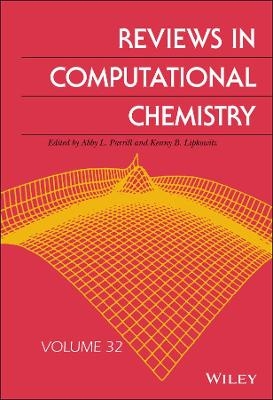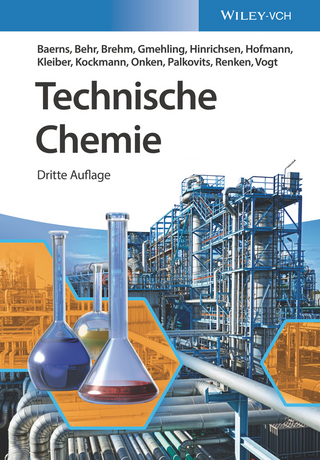
Reviews in Computational Chemistry, Volume 32
John Wiley & Sons Inc (Verlag)
978-1-119-62589-6 (ISBN)
Reviews in Computational Chemistry reference texts assist researchers in selecting and applying new computational chemistry methods to their own research. Bringing together writings from leading experts in various fields of computational chemistry, Volume 32 covers topics including global structure optimization, time-dependent density functional tight binding calculations, non-equilibrium self-assembly, cluster prediction, and molecular simulations of microphase formers and deep eutectic solvents. In keeping with previous books in the series, Volume 32 uses a non-mathematical style and tutorial-based approach that provides students and researchers with easy access to computational methods outside their area of expertise.
The chapters comprising Volume 32 are connected by two themes: methods that can be broadly applied to a variety of systems, and special considerations required when modeling specific system types. Each in-depth chapter contains background and theory, strategies for using the methods correctly, mini-tutorials and best practices, and critical literature reviews highlighting advanced applications. Essential reading for both newcomers and experts in the area of molecular modeling, this state-of-the-art resource:
Covers topics such as non-deterministic global optimization (NDGO) approaches and excited-state dynamics calculations
Contains a detailed overview of deep eutectic solvents (DESs) and simulation methods
Presents methodologies for investigating chemical systems that form microphases with periodic morphologies such as lamellae and cylinders
Features step-by-step tutorials on applying techniques to probe and understand the chemical dynamics exhibited in a system
Includes detailed subject indices on each volume in the series and up-to-date compendiums of molecular modeling software, services, programs, suppliers, and other useful information
Reviews in Computational Chemistry, Volume 32 is a must-have guide for computational chemists, theoretical chemists, pharmaceutical chemists, biological chemists, chemical engineers, researchers in academia and industry, and graduate students involved in molecular modeling.
ABBY L. PARRILL, PhD, is Professor of Chemistry in the Department of Chemistry and Dean of the College of Arts and Sciences at the University of Memphis. Her research interests are in bioorganic chemistry, protein modeling, NMR Spectroscopy, and rational ligand design and synthesis. She has given more than 100 presentations and authored numerous papers and books. KENNY B. LIPKOWITZ, PhD, was one of the founding co-editors of Reviews in Computational Chemistry. He spent 28 years as an academician and then moved to the Office of Naval Research, where he is currently a Program Manager in Computer-Aided Materials Design.
List of Contributors ix
Preface xi
Contributors to Previous Volumes xv
1 Non-Deterministic Global Structure Optimization: An Introductory Tutorial 1
Bernd Hartke
List of abbreviations 1
Introduction 2
The Need for Structural Optimization 2
Search Space is Vast 3
Deterministic vs Non-Deterministic Search 5
Fundamental Take-Home Lessons 8
A Closer Look at Some NDGO Background Details 8
Too Inspired by Nature 8
No Free Lunch 11
NDGO Algorithm Comparisons 14
Barrier Crossing 15
Old vs New Machine Learning 19
Take-Home Lessons for NDGO Background Details 20
General Guidelines for NDGO Applications 21
Brief Summary of Some Fundamental NDGO Algorithm Ideas 21
NDGO Method Design Choices 22
NDGO Tips for Absolute Beginners 28
Things to Do, and Pitfalls to Avoid 31
Recent Highlights 32
References 34
2 Density Functional Tight Binding Calculations for Probing Electronic-Excited States of Large Systems 45
Sharma S.R.K.C. Yamijala, Ma. Belén Oviedo, and Bryan M. Wong
Introduction 45
Real-Time Time-Dependent DFTB (RT-TDDFTB) 46
Theory and Methodology 46
Tutorial on RT-TDDFTB Electron Dynamics for a Naphthalene Molecule 49
Absorption Spectrum for Naphthalene 49
Electron Dynamics of Naphthalene with a Laser-Type Perturbation 51
RT-TDDFTB Electron Dynamics of a Realistic Large Systems 51
DFTB-Based Nonadiabatic Electron Dynamics 59
Adiabatic vs Nonadiabatic Dynamics 59
Equations Governing Nonadiabatic Electron Dynamics 61
The Classical Path Approximation 62
Surface Hopping and Fewest Switches Criterion 63
Implementation Details of CPA-FSSH-DFTB 65
Post-processing Tools 67
Computational Details 67
An Example on Charge Transfer Dynamics in Organic Photovoltaics 68
Conclusion and Outlook 72
Acknowledgments 72
References 73
3 Advances in the Molecular Simulation of Microphase Formers 81
Patrick Charbonneau and Kai Zhang
Introduction 81
Block Copolymers 83
Surfactants and Microemulsions 84
Lattice Spin Systems 87
Colloidal Suspensions 87
Other Examples 90
Field Theory of Microphase Formation 90
Molecular Simulations and Challenges 91
Simulating Periodic Microphases 93
Expanded Thermodynamics 94
Thermodynamic Integration for Microphases 95
Ghost Particle/Cluster Switching Method 100
Cluster Volume Moves 103
Determining Phase Transitions 105
Simulations of Disordered Microphases 106
Wolff-Like Cluster Algorithms 106
Virtual Cluster Moves 107
Aggregation Volume Biased (AVB) Moves 109
Morphological Crossovers in the Disordered Regime 110
Microphase Formers Solved by Molecular Simulations 112
One-Dimensional Models 112
Lattice Spin Models 113
Colloidal Models 117
Conclusion 118
Free Energy of an Ideal Gas in a Field 119
Constant pressure Simulations of Particles in A Field 120
Virial Coefficients of Particles in a Field 120
Acknowledgments 122
References 122
4 Molecular Simulations of Deep Eutectic Solvents: A Perspective on Structure, Dynamics, and Physical Properties 135
Shalini J. Rukmani, Brian W. Doherty, Orlando Acevedo, and Coray M. Colina
Introduction 135
Deep Eutectic Solvents 137
Definition of Deep Eutectic Solvents 137
DES as Ionic Liquid Analogues 137
Molecular Structure of DESs and Type of Interactions 140
Types of DES 142
Molecular Simulation Methods 143
An Overview of Ab Initio Methods 145
Classical Molecular Dynamics at the Atomic Level 149
Nonpolarizable Force Fields used for DES Simulations 153
Physical Properties 159
Liquid Density 159
Volume Expansivity 162
Surface Tension 162
Thermodynamic Properties 164
Heat Capacity 164
Heats of Vaporization 168
Isothermal Compressibility 169
Transport Properties 170
Viscosity 170
Diffusion Coefficients 178
Deep Eutectic Solvent Structure 183
Radial Distribution Functions 183
Hydrogen Bond Analysis 189
Spatial Distribution Functions 196
Application of DES Through Simulation 196
Gas Sorption Studies on DES 196
DES Interactions at Metal Surfaces 198
Proteins in DES 199
Summary 200
Acknowledgments 201
References 201
Index 217
| Erscheinungsdatum | 07.03.2022 |
|---|---|
| Reihe/Serie | Reviews in Computational Chemistry |
| Verlagsort | New York |
| Sprache | englisch |
| Maße | 10 x 10 mm |
| Gewicht | 454 g |
| Themenwelt | Naturwissenschaften ► Chemie ► Technische Chemie |
| Technik ► Maschinenbau | |
| ISBN-10 | 1-119-62589-0 / 1119625890 |
| ISBN-13 | 978-1-119-62589-6 / 9781119625896 |
| Zustand | Neuware |
| Informationen gemäß Produktsicherheitsverordnung (GPSR) | |
| Haben Sie eine Frage zum Produkt? |
aus dem Bereich


